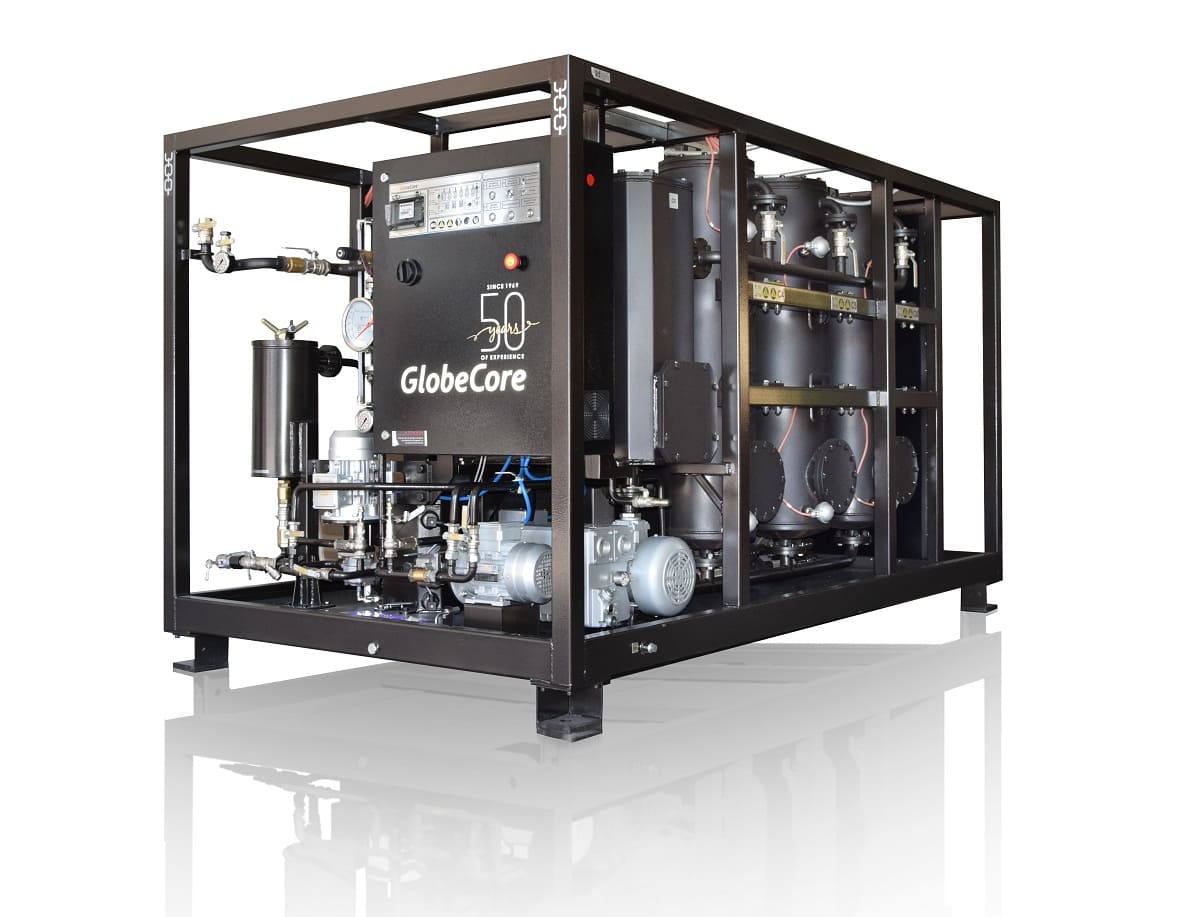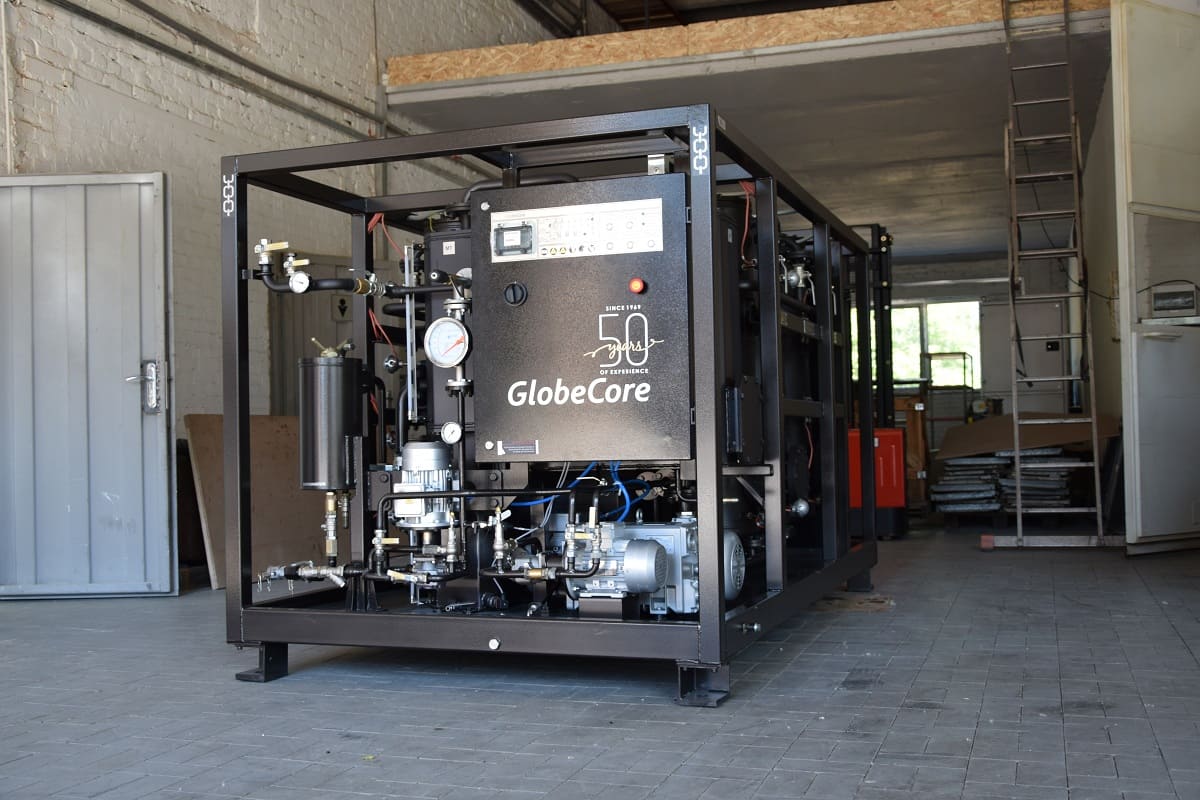CMM-6RL low-viscosity marine fuel polishing machine

CMM-6RL
-
Advantages
- Convenience of operation. The unit is quickly connected to tanks for clean and dirty oil through camlock quick couplings; the oil purification process is visually monitored by means of sight glasses; a service hatch is provided at the bottom of the columns for their maintenance and cleaning.
- The unit can operate in automatic mode. The required operating mode is selected, and the actuators are controlled from the touch panel which displays a mnemonic diagram of the unit. In order to enable the control buttons, the operator just needs to touch them.
- The adsorbent is reclaimed without being removed from the unit and can be used for the next regeneration cycle immediately after cooling. At the end of the last reactivation, the adsorbent can be used as a construction aggregate or in agriculture to loosen compact soils.
- There occur no harmful emissions into the environment during the unit operation. The unit is equipped with a two-stage system for neutralization of combustion products which consists of a carbon filter and a catalytic converter.
Fuel expenses account for the majority of operating costs in navigation. Low-viscosity marine fuel is most often used in medium- and high-speed diesel engine plants. It resembles automotive diesel fuel, but has some differences:
- lower cetane number;
- higher sulfur content;
- higher viscosity.
Thus far, the use of low-viscosity marine fuel has faced no restrictions; however, tightened environmental laws compel river and marine fleets to switch to fuels with a low sulfur content. The price of such fuels is very high and in order to save money, cheaper marine fuels are used and require to be first prepared by reducing the content of environmentally unwanted impurities, including sulfur.
Methods for preparation of low-viscosity marine fuel
Filtration, gravity-induced and centrifugal purification are used in preliminary preparation of low-viscosity marine fuel. These methods are focused rather on removal of mechanical impurities and water from the fuel, but have little effect on the content of impurities that are more harmful to the environment.
In order to address this task, it is advisable to use purification and clarification of low-viscosity marine fuel by means of adsorbents.
Low-viscosity marine fuel polishing in CMM-6RL unit
Adsorbent-based low-viscosity marine fuels polishing are implemented in CMM-6RL unit from GlobeCore. This unit consists of 6 columns filled with natural adsorbent.
The fuel is pumped through the columns, and the adsorbent captures harmful impurities and retains them in its granules due to its well-developed absorptive abilities. At the outlet of the unit, we obtain clarified low-viscosity marine fuel with a reduced sulfur content which will be completely ready for use in marine diesel engine plants and which is compliant with environmental law regulations.
Operation features of CMM-6RL unit
The disadvantages of the adsorptive method for purification of oils and fuels include the need to stockpile and dispose of the used adsorbent. GlobeCore equipment does not have this problem, because the properties of the adsorbent are reclaimed by burning it without removing from the columns. After reactivation and cooling, the adsorbent can be reused for purification and clarification of low-viscosity marine fuel.
Duration of operating cycles and power consumption
CMM-6RL unit for purification and clarification of low-viscosity marine fuels sequentially operates in the following modes:
- Fuel polishing (duration — 6 h, power consumption — 1.5 kW/h);
- Adsorbent reactivation:
- preparation (duration — 1 h, power consumption — 6.25 kW/h);
- adsorbent ignition (duration — 1 h, power consumption — 17.5 kW/h);
- adsorbent combustion (duration — 15 h, power consumption — 25.5 kW/h);
- refilling (duration — 0.5 h, power consumption — 6.5 kW/h).
| No. | Parameter | Value |
| 1 | Capacity, m3/h | 0.45* |
| 2 | Sorbent reactivation time, not more than | 19 hours |
| 3 | Required power consumption, kW | 14.5 |
| 4 | Three-phase 50, 60 Hz AC power supply voltage, V | 380 |
| 5 | Dimensions, mm, not more than
– length – width – height |
2820 1570 1520 |
| 6 | Weight, kg, not more than | 2100 |
* – in order to obtain the best result of low-viscosity marine fuel polishing, it is recommended to first remove mechanical impurities by means of CMM-4.0F unit and water — by means of CMM-1.0CF unit.
Equipment configurations that are not included in this configurator can be implemented via a separate request to [email protected].Aplication :
- Convenience of operation. The unit is quickly connected to tanks for clean and dirty oil through camlock quick couplings; the oil purification process is visually monitored by means of sight glasses; a service hatch is provided at the bottom of the columns for their maintenance and cleaning.
- The unit can operate in automatic mode. The required operating mode is selected, and the actuators are controlled from the touch panel which displays a mnemonic diagram of the unit. In order to enable the control buttons, the operator just needs to touch them.
- The adsorbent is reclaimed without being removed from the unit and can be used for the next regeneration cycle immediately after cooling. At the end of the last reactivation, the adsorbent can be used as a construction aggregate or in agriculture to loosen compact soils.
- There occur no harmful emissions into the environment during the unit operation. The unit is equipped with a two-stage system for neutralization of combustion products which consists of a carbon filter and a catalytic converter.
Aplication :
GlobeCore’s CMM-R units can be used for:
- low-viscosity marine fuel polishing;
- transformer oil regeneration;
- turbine oil regeneration;
- hydraulic oil regeneration;
- gear oil regeneration;
- industrial oil regeneration;
- silicone oil regeneration;
- regeneration of dielectric fluid Midel 7131;
- regeneration of FR3 dielectric fluids;
- gas condensate regeneration;
- diesel fuel polishing;
- fuel oil polishing.
Aplication :
Aplication :
Equipment configurations that are not included in this configurator can be implemented via a separate request to [email protected].
Aplication :



